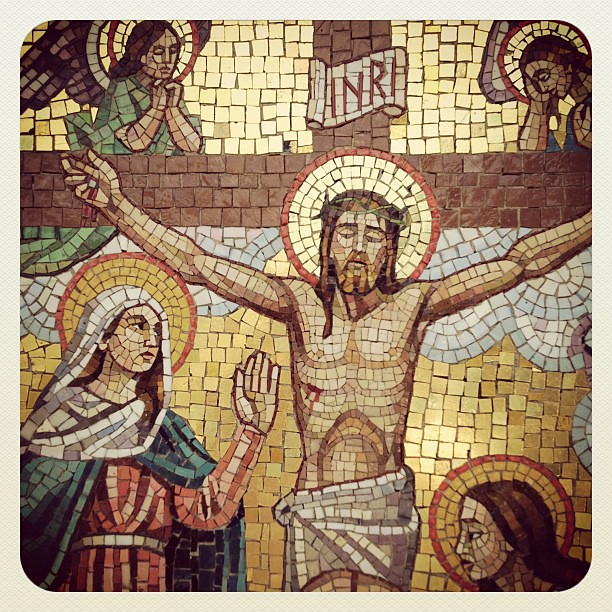All Activity
- Today
-

Poor Clare Colettine Nuns, Annunciation Monastery, Minooka, IL
graciandelamadrededios replied to graciandelamadrededios's topic in Catholic Vocation Station
you're welcome! -
nikita92 started following Poor Clare Colettine Nuns, Annunciation Monastery, Minooka, IL
-
.thumb.png.46da1ce38a0765fb03760bd399f2b8c8.png)
Poor Clare Colettine Nuns, Annunciation Monastery, Minooka, IL
nikita92 replied to graciandelamadrededios's topic in Catholic Vocation Station
Thank you for sharing this insightful information! -

Poor Clare Colettine Nuns, Annunciation Monastery, Minooka, IL
graciandelamadrededios posted a topic in Catholic Vocation Station
I just noticed that the Poor Clare Colettine Nuns of Minooka has resumed wearing the white kerchief that covers the chin. Thank you, Margaret Clare for mentioning this to me. They also wore larger and longer veils that almost reach the back of their knees. THE RULE OF ST. CLARE AND THE CONSTITUTIONS FOR POOR CLARE NUNS OF THE REFORM OF ST. COLETTE 1932 CHAPTER II. Of the Quality of the Habit and of the other Garments 20. - Since the Rule of Form of life lays down that the Sisters be clothed with poor garments, we ordain and decree that this poverty, both with respect to price and colour, be attended to. 21. - Although it is laid down in the Form of life that the Abbess shall supply and provide the person who enters, on her laying aside her secular dress, with three tunics and a mantle, nevertheless, if necessity or infirmity, or any circumstances of person or of place or time should cause any one to need more garments, we declare that the Abbess shall provide the Sisters with garments according to the qualities according to the qualities of persons and places and times and cold climates, as necessity may seem to require. 22. - It is to be understood that the three tunics mentioned in the Form of life need not be of the same form or shape, since the two inner tunics are allowed, not so much as being part of the Habit of the Order as for the comfort and heat and decency of the body; nor need they be of the same colour. 23. - Wherefore, we direct and ordain that the outer tunic be designated as the Habit of the Order, without which the Sisters may not appear in public, nor retire to sleep, unless illness or infirmity or any other manifest necessity, which has been declared to be sufficient either by the Abbess or her Vicaress, should warrant them to act otherwise. 24. - Let the length of the habit be such that, when worn, it shall not exceed the stature of the person who wears it and train along the ground; and the width shall not exceed fourteen palms. The sleeves shall not extend beyond the first finger joints. 25. - The inner tunics shall be of poor cloth, and may not be lined with skins or furs. 26. - The mantle also shall always be of poor and course cloth, and shall not be gathered or pleated about the neck; nor so long as to train in anyway along the ground. 27. - Let plainness, austerity and poverty, both with respect to texture, cost and colour, be always apparent in all the garments of the Sisters. 28. - Let all the Sisters, both the Abbesses and other Officials, be clad with the same common cloth, and let all partiality be excluded. 29. - The cord, with which the Sisters are girt, shall be plain and common, and shall be free from all manner of singularity. 30. - For the rest, with regard to the covering of the head, we prescribe and ordain that all the Sisters, both the Abbesses as well as the other professed members, without any distinction whatever, shall in all humility, modesty and piety, cover their heads and avoid singularity and vanity of all kinds. 31. - That this be the better observed at all times and by all Sisters in their Convents in every place, we decree that all the Sisters shall so adjust their kerchiefs, that the forehead, both cheeks and the chin shall be for the greater part covered, so that their faces may be in no wise entirely seen. 32. - Besides, the veils and all the kerchiefs that are worn on the head and about the neck shall be so arranged that they cover all the head, the greater part of the chest and the corresponding part of the body at the back. 33. - Furthermore, we direct that all veils and kerchiefs be of common, course and plain linen, so that the holy poverty and austerity of their profession may ever shine forth in them. 34. - Moreover, in order that cleanliness be always attended to, we declare that each Sister, with the consent and permission of her Abbess, may have two black veils and two or three changes of white kerchiefs. 35. - Let all the Sisters beware lest they have pleated kerchiefs, or kerchiefs of silk or of any other costly material. 36. - Finally, no novice may wear the black veil before she has made her profession, but she shall wear the white kerchiefs, suitably arranged according to the direction of the Abbess, as has been heretofore the custom. -
S5.4 Je vous salut Marie, pleine de grâce, le Seigneur est avec vous, vous êtes bénie entres toutes les femmes et Jésus, le fruit de vos entrailles est béni. Sainte Marie, Mère de Dieu, priez pour nous pécheurs, maintenant et a l'heure de notre mort. Amen
- Yesterday
-
S5.3 Je vous salut Marie, pleine de grâce, le Seigneur est avec vous, vous êtes bénie entres toutes les femmes et Jésus, le fruit de vos entrailles et béni. Sainte Marie, Mère de Dieu, priez pour nous pécheurs, maintenant et a l'heure de notre mort. Amen
- Last week
-

Catholic Church's Claims Are Weak In Early History, Regarding Papa
Didacus replied to dairygirl4u2c's topic in Catholic Debate Table
Much agreed on this point. -
https://suno.com/song/0ed8b98c-d70a-4721-8d4f-20bcc0589437?sh=EQCM4QPv6cDrvqSw What a tango!
-
S5.2 Je vous salut Marie, pleine de grâce, le Seigneur est avec vous, vous êtes bénie entres toutes les femmes et Jésus, le fruit de vos entrailles est béni. Sainte Marie, Mère de Dieu, priez pour nous pécheurs, maintenant et a l'heure de notre mort. Amen
-

Franciscan Sisters And Friars Sojourn to Young Adults in Arizona
Francis Coffee posted a topic in Catholic Vocation Station
St Thomas Parish, Tucson, Arizona was the gathering place for over forty Catholic young adults to reflect, discuss, pray and enjoy being together for a Franciscan presentation on the Eucharist. Franciscan Sister of Christian Charity Sister Mary Ann Spanjers guided the evening with an emphasis on how much God is in love with us! “I appreciated sharing with those at my table their experiences with the Eucharist and Adoration. It was good to hear the stories told about the life of St. Francis and both Brother and Sister’s lives.” https://fscc-calledtobe.org/2025/03/26/tucson-catholic-young-adults-gather-for-eucharist-reflection-by-franciscans/ -
The Fifth Corrowful Mystery The Crucifixion and Death Le Cinquième Mystère Douloureux La Crucification et la Mort Notre Père, qui est au cieux, Que Ton nom soit sanctifier, Que Ton règne vienne, Que Ta volonté soit faite, sur la terre comme au ciel, Donne nous aujourd'hui, notre pain de ce jours, Pardonnes-nous nos offenses, comme nous pardonnons aussi a ceux qui nous ont offensé Ne nous soumet pas a la tentation, mais d`élivres-nous du mal. Amen S5.1 Je vous salut Marie, pleine de grâce, le Seigneur est avec vous, vous êtes bénie entres toutes les femmes et Jésus, le fruit de vos entrailles est béni. Sainte Marie, Mère de Dieu, priez pour nous pécheurs, maintenant et a l'heure de notre mort. Amen
-
Agreed 100% Ironically perhaps, and maybe the source of the inclusion, fyi, in French Canadien history, it was common for the name Blanche (White in french) to be given to a new born girl if she was born during or near a major snow storm. In folklore, the the name 'Blanche' is given to a new born baby girl who wa born outside during a major snow storm... Just saying... traditionally, French Canadien name 'Blanche' is given in much the fashion you describe above. I myself had a great aunt who carried the name 'Blanche'. That being said - I'm glad it was a flop^and I would hat e that my ancestry contributed to this bastardization of a timeless classic.
-

ROME (AP) — Pope Francis is in critical condition
Didacus replied to little2add's topic in Catholic Open Mic
Things are looking better now. But remember, no one is immortal. Our Lord Himself passed through death. -

ROME (AP) — Pope Francis is in critical condition
little2add replied to little2add's topic in Catholic Open Mic
I thought so too. -

Trad wife movement vs working wives
little2add replied to Anastasia13's topic in Catholic Debate Table
Till death do us part, is really only a half truth! BTW -
ROME (AP) — Pope Francis is in critical condition
GraceUk replied to little2add's topic in Catholic Open Mic
Pope Francis looked very frail when I saw a clip of him on TV. And e was breathless after speaking only a few words. Hopefully, after a good rest his health will improve -
The Gospel we just heard is sometimes called the ” Story of the Prodigal Son” or the “Story of the Two Sons” Or the “Story of the Forgiving Father.” This story asks each of us an important question: Will you go in? Will you go in to the feast of forgiveness, will you go in to the party where all are welcome, or will you remain outside? The Biblical record indicates that Jesus was addressing the scribes and the Pharisees. However, it is reasonable to conclude that sinners who had come to see Jesus also heard His words—for it was about them that He spoke. We know the son’s request in this parable is outrageous in every way. In this ancient culture land confers identity and status on the family. This boy is calling for a premature division of the land – move that will diminish the standing and welfare of the whole family. So it is a blow directed not at his father but at the older brother and the rest of the family. The family suffers disgrace. The boy will become isolated because of this disrespect. The family will be ridiculed for letting this happen. The father gives the son what he wants. The son squanders everything and there’s an economic recession that makes things harder and the son can only find a job feeding pigs. The boy is according to Jewish standards an outcast. He’s feeding pigs and is a Gentile. He thinks about his father and goes home. As he nears his home he sees his father running towards him. His father flings his arms around him. The father wants to reward his son with everything he has left. My son’s not dead; he’s alive! He’s not lost; he’s been found!” There’s no lecture, no suggestion that he go inside and apologize to his mother. What does happen is welcome, and celebration. Will this boy go into the feast of forgiveness? The younger son travels home in sorrow yet finds an unexpected welcome. Will he go into the feast of forgiveness, or will he stay outside? There’s also the elder son. He has his own way of remaining outside. Mark Twain describes him perfectly as “a good man in the worst sense of the word.” He’s upstanding, a hard worker, respected by others, fit to inherit the farm, but he’s also a reservoir of resentment. The elder son comes home after a long, hard day to find the house unexpectedly alive. This makes the elder son suspicious. Still outside, he finds out from a farmhand that the party’s for his brother. He remains outside, yelling insults at his brother and father. The father, now anxious, goes outside to his angry elder son who expresses many resentments. Finally, the father gets a word in. The truth is, he loves both his sons. To welcome the wastrel is no loss for the elder: it means the elder brother has gained his sibling back. The elder brother has also fled from his father. For years he has ignored his father’s kindness. A false, image of a demanding father has held sway over him and made life miserable for those around him. The real father tries to shatter this illusion. He wants his older son to return home, too. Will the elder son go in where all are welcome ? Or will he remain outside, isolated in anger? This elder brother lives in many people. Their sin is one of quiet forgetfulness. They overlook their blessings. Their appreciation turns dull. They feel sorry for themselves, become jealous of others, and strive all the harder to be worthy. They have no taste for a party that welcomes home a prodigal. But the door remains open. How about you? Will you go in to the feast of forgiveness, will you go in to the party where all are welcome, or will you remain outside? Remember who tells the story: Jesus Christ. He does not simply talk about the Father; the Father dwells in him. He does not simply speak of our return; he invites us back. He does not simply describe the party; he makes that party possible. Lent is a time for conversion. My prayer today is that we may all come to know we are loved as the Prodigal Child, to know we must love as the parent, and to know that to love and be loved we must wrestle with our darkness as the elder sibling. We have responded to his story because we are here, here inside our Father’s house. Now comes the feast of forgiveness, the banquet of our eternal home.
- Earlier
-
The performatively progressive ” Disney's Snow White live action remake flopped and flopped HARD. Disney’s live action remake of the 1930s classic “Snow White” is on track to be one of the biggest flops of the year. It cost more than $270 million to make but its big opening weekend debut amounted to about $43 million domestically. This should be a GIANT wake up call for Disney. the Brothers Grimm fairytale “Snow White,” describes the protagonist as having “skin as white as snow.”, but the lead character (Disney's remade Snow White) has stating for the record that the title character name for or after - surviving a snowstorm as a child? Very strange . The movie’s “pseudo-progressive” approach to portraying the seven dwarves as CGI-animated figures and referred to them as “magical creatures” in the movie, instead of cute little dwarf's ( Bashful: the shy dwarf, Doc: the leader dwarf, Dopey: the silly dwarf, Grumpy: the surly dwarf, Happy: the cheerful dwarf, Sleepy: the tired dwarf last but not least Sneezy: the sneezing dwarf strange too
-

Trad wife movement vs working wives
Norseman82 replied to Anastasia13's topic in Catholic Debate Table
There is a difference between "expecting to separate" versus protecting yourself in case one's spouse is no longer around. A spouse can die or become disabled or be an innocent victim of a separation. What then? -

ROME (AP) — Pope Francis is in critical condition
little2add replied to little2add's topic in Catholic Open Mic
March 23, 2025 VATICAN CITY (AP) — A frail Pope Francis returned to the Vatican on Sunday after a five-week hospitalization for life-threatening double pneumonia, and he made a surprise stop at his favorite basilica on the way home before beginning two months of prescribed rest and recovery. -
Jesus is on a prophetic journey from Galilee to Jerusalem, preaching and teaching along the way. Crowds have gathered to hear him speak. Some of those present bring up the fate of some Galileans brutally murdered by Pilate while they were at prayer in the Temple in Jerusalem. Were they sinners? Did they deserve their fate? Jesus speaks clearly to his listeners. These were random events, not meant as examples of divine punishment. These people did not die because they were sinners. They died because life is fragile and unpredictable. Jesus addresses those of us who have survived thus far. We should not mistake our good fortune for God’s special blessing. He repeats twice, for emphasis: Unless you repent, you will all perish as they did. Perish has a double meaning. We can perish both outwardly and inwardly: the concrete death of the body, and the abstract death of the soul. As we pray in the collect of the day: Keep us both outwardly in our bodies and inwardly in our souls. Jesus is speaking of death in an eschatological sense, the destruction of the soul. The warning is unmistakable: Repent before it is too late. Indeed, anything could happen at any time. Wildfire, flood, terrorism, cancer diagnosis. Awareness of life’s fragility creates urgency. The unrepentant may suddenly find they have delayed too long. Yet while we live, it is not too late. Jesus follows his warning with the Parable of the Barren Fig Tree. In the parable, bearing fruit is an image of repentance. This tree may continue to live without bearing fruit because it has been granted additional time, unlike the victims of the disasters in the first part of the passage. The gardener in the parable is a good steward of souls. Give them another chance, offer them some support, perhaps they’ll see the light. But unless the tree makes good use of the additional time, the result will be its destruction. Time to repent, like life itself, is not infinite. St Paul’s letter to the Corinthians, in contrast, depicts a time when God punishes those who have actually failed to be faithful He is critical of those who boast that they have special wisdom or knowledge of correct religious practice. Paul warns us: So if you think you are standing, watch out that you do not fall. St Paul could also be thinking of the Gospel Parable of the Barren Fig Tree when he is writing. God is patient, forgiving, even hopeful for humankind. We’ve heard a great deal about repentance, from St John the Baptist to Jesus to St Paul. So, what does it mean, to repent? The Oxford Dictionary affirms what most of us would answer: to “feel or express sincere regret or remorse about one’s wrongdoing or sin” . Mea culpa, mea culpa, I have sinned. Yes, to repent is to regret past sins. What about concrete action? If possible, to correct those sins, and to move forward doing good deeds? In a spiritual sense, repentance might mean a change of mind, of perspective, a new way of seeing things. Repentance might mean that, as Christians, we are called to seize the opportunity for joy in God’s grace. Now, the gospel passage is about urgency. Our existence is precarious. God is patient, but the parable implies perhaps not infinitely so. Our time is running out. What does repentance look like in a time of uncertainty, when we can control so little, when injustice spins out of control? What about this possibility: Be as kind and helpful as possible in daily life. Work toward being compassionate, aware, conscious, civic-minded. Be a fertile part of the village, even when it’s not necessarily easy or convenient. Repentance is not a one-and-done occurrence. As Paul writes, if you think you are standing, watch out that you do not fall. Repentance is ongoing, a daily, even hourly, process. In the face of life’s fragility, unpredictability, and urgency, let us consider repentance as a practice. Beginning with a Lenten practice, may we begin to consider and act upon the ways we can contribute to our communities. A smile, a compliment. An act of kindness and help. Generosity, financial and with presence. Keeping our planet healthy in ways large and small. Jesus teaches us that a disaster could happen at any time, through no fault of our own. St Paul reminds us that a failure to be faithful could happen to anyone. In either case, we must be vigilant and humble, and we must repent. These are the messages of Lent. Our time is running out. May we live our lives in a state of repentance.
-

Mother Marie Thérèse of the Holy Eucharist, PCC = former Abbess of Poor Clare Monastery of Our Lady of Mercy, Belleville, Illinois
graciandelamadrededios replied to graciandelamadrededios's topic in Catholic Vocation Station
There is a photo of Mother Marie Therese taken during her profession with two other Nuns, all of which wore the kerchief covering their chin. Mother was also mentioned in the book of Mother Mary Francis when she accompanied her during one of her foundations. Unfortunately, I have difficulty posting photos here. -

The Convent of the Blessed Sacrament in Baguio City, Philippines during the war (WWII)
graciandelamadrededios replied to graciandelamadrededios's topic in Catholic Vocation Station
This convent is the old Convent of the Pink Sisters when they relocated to Baguio from Lipa. After the war they transferred to another location but still within Baguio City. -

The Convent of the Blessed Sacrament in Baguio City, Philippines during the war (WWII)
graciandelamadrededios replied to graciandelamadrededios's topic in Catholic Vocation Station
Lydia Ysip (b,30.1.1919 in Cabiao) was still a postulant when she died. Her father was a judge and a man of upright character. Lydia was a chemistry student. After her studies she wanted to become a nun but her father advised her to wait and think the matter over for some time. So she became a teacher. In 1943 she applied to enter Baguio and entered on 23 November. The obituary states: "From the moment of her entry she was a model of religious detachment and recollection. In every respect her behavior was exemplary." She gave harmonium lessons. No work was too much or too difficult for her. She was simple and undemanding and was immensely happy about the coming day of her investiture on May 8. When she was found after the bombing she seemed to be still alive but made no movement. One foot had been torn off. The cause of death was probably the strong air pressure of the exploding bomb. The postulant Remedios Venezuela was the daughter of a respected landowner in Pangasinan. Born on 24 April 1919, she studied at the Holy Spirit College in Manila and togethen with Lydia Ysip on 21 November 1943 entered the convent in Baguio. Though as the only child of the family she was "somewhat spoilt" she soon began to cope with convent life. Because of her friendly disposition she was loved by all. She often volunteered for extra work. She loved nature. The air-raid attacks terrified the somewhat fearful postulant so much she also asked to go to Tuba which was reckoned to be safer. The she died. The obituary states: "A large pice of metal struck her on the breast which became a great open wound. A locket containing a relic of the Little Flower which she always carried round her neck had sunk into the wound and was now filled with blood. But the thin face - which didn't show the slightest trace of injury - glowed with the most profound peace." -

The Convent of the Blessed Sacrament in Baguio City, Philippines during the war (WWII)
graciandelamadrededios replied to graciandelamadrededios's topic in Catholic Vocation Station
Sr. M. Angeles, Aurora Tioseco, entered in Baguio on 14 August 1936. She was 25. She was the eldest of her family and accustomed to asserting her authority. She found obedience and subjection in the convent a great burden but she learnt to overcome her feelings. It was said of her that she was "humble of heart." She loved praying much and used every chance she could to practice penance and mortification. She made her first profession on 8 May 1940. She never made her final profession. About her death the chronicle states: "When cruel death knocked her over unexpectedly on 6 March 1945 she was holding her hand that lovely English meditation book "Vigil." No external wounds could be seen. The terrible air pressure which her heart could not withstand must have killed her instantly. She looked so natural, as if she were sleeping." Sr. M. Caridad, Marcelina Lainez, entered Baguio on 21 June 1941. She was 30 years old and a teacher. She had to wait ten years to get permission from her parents to enter. Settling down was not a problem for her. The chronicle notes: "She was willing to make sacrifices, modest and undemanding. At all times she demonstrated a great respect and obedience for the prescriptions of our rule. As a Novice Sr. M. Caridad had to do much work she had never turned her hand before. But she was willing, trustworthy and faithful. You could depend on her." On 21 November 1944 she completed her second year of novitiate. But since the superior and official novice mistress were absent she was advised to put her profession off until May. The chronicle graphically describes her death wounds: Above her brow we saw 2-cm-wide wound stretching from temple to temple. The back of her head was completely crushed." -

The Convent of the Blessed Sacrament in Baguio City, Philippines during the war (WWII)
graciandelamadrededios replied to graciandelamadrededios's topic in Catholic Vocation Station
Sr. M. Paula, Trinidad Lazo, was the second eldest Philippine Sister. The child of a very good Catholic family from Vigan, at the age of 18 she entered in Lipa on 19 June 1931. The family wanted her to be a doctor but she herself preferred to spend her life a contemplative sister. She was killed while working in the kitchen. Sr. M. Sebastiana, Asuncion Altamirano, was a native of Lipa. She was 27 and with a college education when she entered the local adoration convent on 3 June 1932. She felt completely happy there. As the chronicle puts it: "Retiring and friendly by nature, she was pleasant companion both at work and at play. Her youthful, hearty laugh worked like a tonic on others. Though she spent most of her time in the kitchen she found time to exercise her many other talents. Sr. M. Reparatrix, Maria Abad, was from San Juan, La Union. Before entered (14.8.1936) she was a teacher. She was accepted into the convent in Lipa but her father stubbornly refused to give his permission, so she had to wait till after his death. The eldest of three postulants in Baguio, she received the habit on 8 May 1398. The eldest of the three postulants in Baguio, she received the habit on 8 May 1938. The chronicles remarks: "Very soon the small, lively Sr. Abad - despite her homesickness - felt very much at home with us." Her main place of work was the sewing room. The air-raid on January gave her such a shock that she never got over it. Her own cell was badly damaged. So, though with heavy heart, she volunteered to be among the first group of Sisters to move to Tuba. On the way she said to herself: "I simply can't, I will go back," and on 5 March she asked correction: hus, Sr. M. Reparatrix too became a victim for the Lord. Sr. M. Paula, Trinidad Lazo, was the second eldest Philippine Sister. The child of a very good Catholic family from Vigan, at the age of 18 she entered in Lipa on 19 June 1931. The family wanted her to be a doctor but she herself preferred to spend her life a contemplative sister. She was killed while working in the kitchen. Sr. M. Sebastiana, Asuncion Altamirano, was a native of Lipa. She was 27 and with a college education when she entered the local adoration convent on 3 June 1932. She felt completely happy there. As the chronicle puts it: "Retiring and friendly by nature, she was pleasant companion both at work and at play. Her youthful, hearty laugh worked like a tonic on others. Though she spent most of her time in the kitchen she found time to exercise her many other talents. Sr. M. Reparatrix, Maria Abad, was from San Juan, La Union. Before entered (14.8.1936) she was a teacher. She was accepted into the convent in Lipa but her father stubbornly refused to give his permission, so she had to wait till after his death. The eldest of three postulants in Baguio, she received the habit on 8 May 1398. The eldest of the three postulants in Baguio, she received the habit on 8 May 1938. The chronicles remarks: "Very soon the small, lively Sr. Abad - despite her homesickness - felt very much at home with us." Her main place of work was the sewing room. The air-raid on January gave her such a shock that she never got over it. Her own cell was badly damaged. So, though with heavy heart, she volunteered to be among the first group of Sisters to move to Tuba. On the way she said to herself: "I simply can't, I will go back," and on 5 March she asked to accompany the group that went back to Baguio for provisions but did not go. When the bomb fell the next morning at 9:00 a.m. in Tuba she was inside the house. A bomb fragment hit her in the back and penetrated her liver and other organs. It could be seen protruding on the other side under the skin. It was 3:00 p.m. before the doctor came. He removed the piece of steel; but it was too late. Before she died Fr. Urban heard her confession and administered the last rites.



